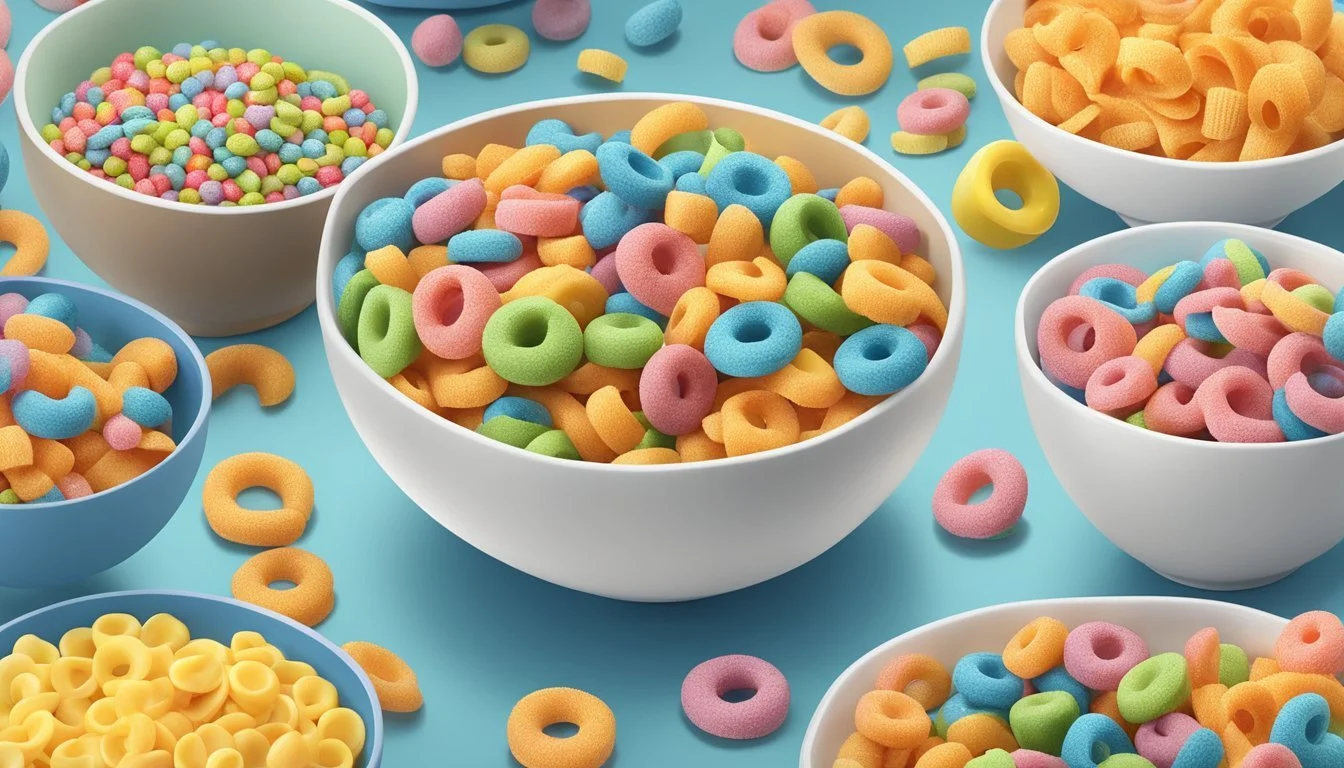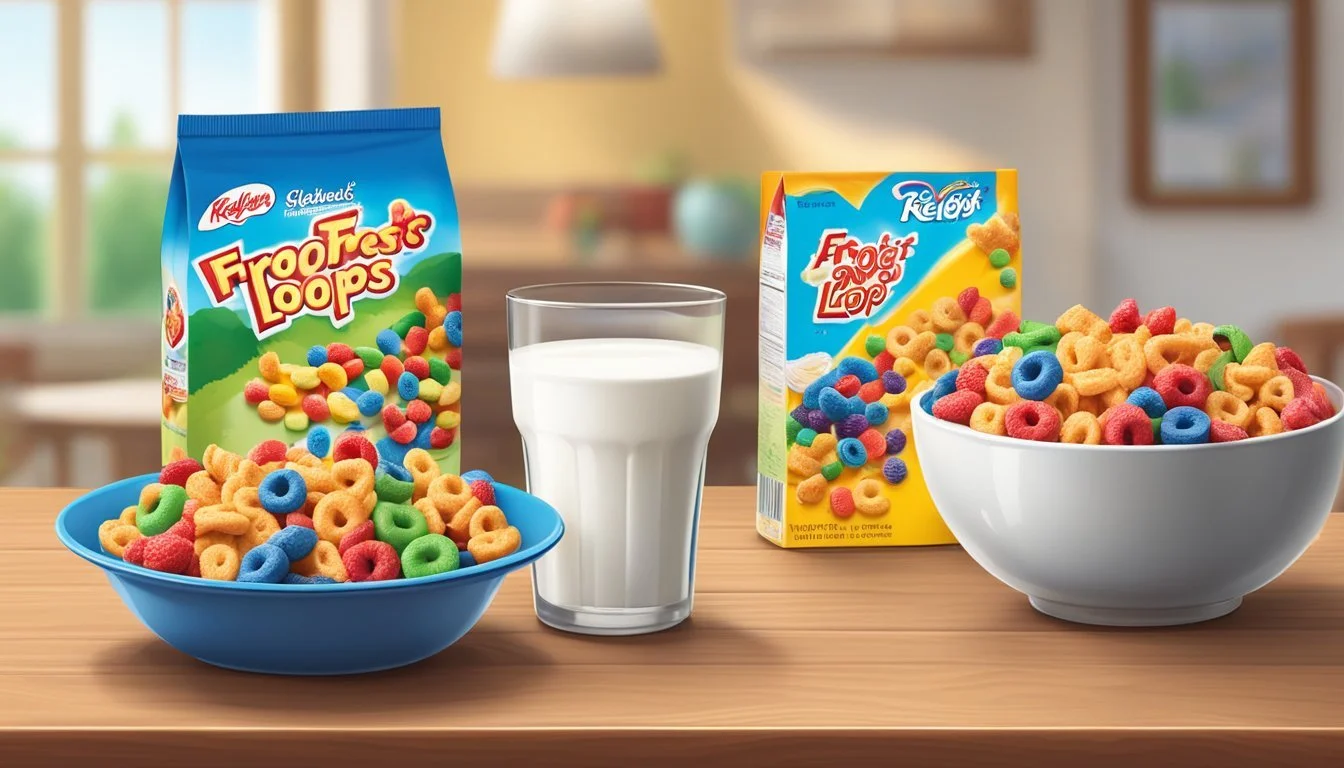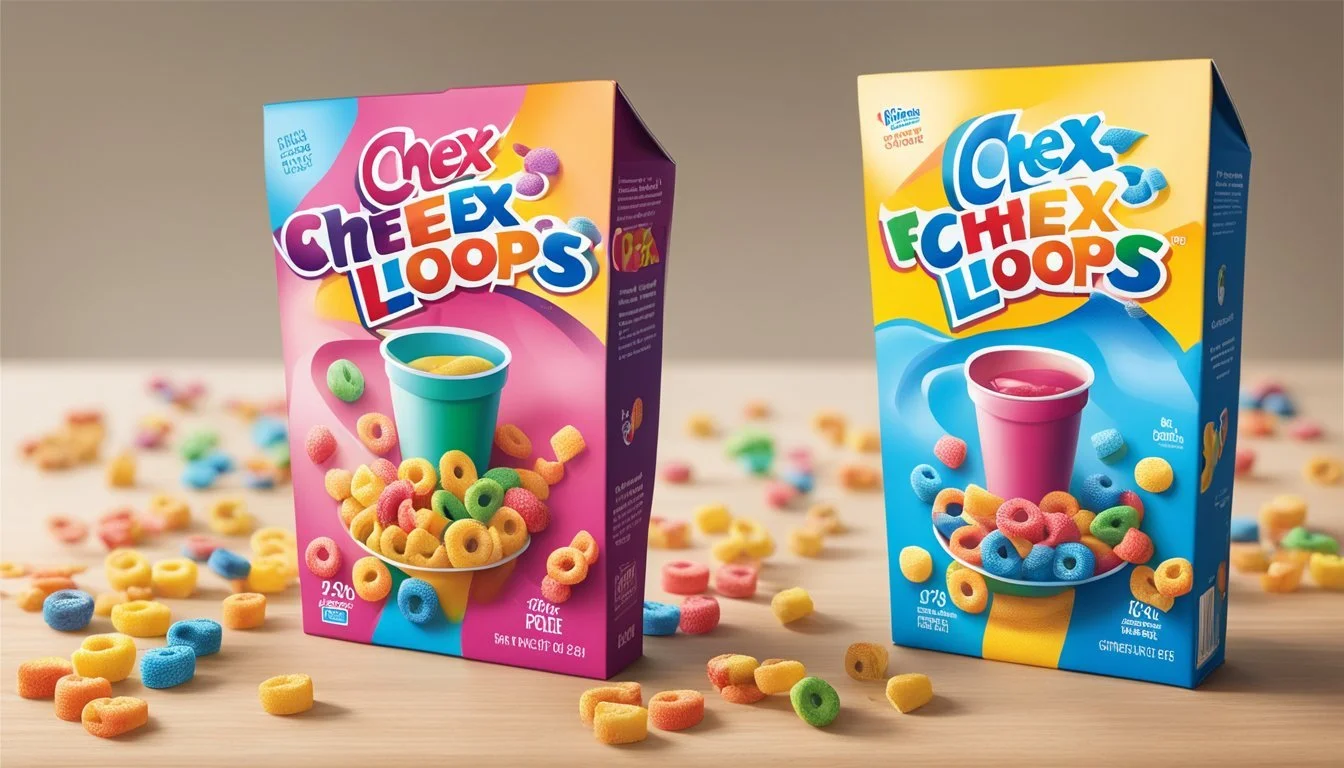Chex vs Kellogg's Froot Loops
A Detailed Breakfast Cereal Comparison
This Article is Part of Our Breakfast Cereal Guide with Details on Chex Nutrition and Kellogg's Froot Loops Nutrition
When it comes to choosing between Corn Chex and Kellogg's Froot Loops, the difference in nutritional content stands out. Corn Chex, a product of General Mills, offers a low-calorie, low-sugar option, making it an appealing choice for health-conscious individuals. Chex is notably better for those looking to limit their sugar intake and maintain a balanced diet.
In contrast, Kellogg's Froot Loops, a colorful and beloved childhood favorite, doesn't fare as well in terms of health benefits. This cereal is high in sugar and contains less dietary fiber, making it less ideal for those watching their nutritional intake. Despite its fun appearance and nostalgic value, Froot Loops may not be the best option for a nutritious start to the day.
By weighing the nutritional facts, it's clear that Chex provides a healthier alternative to the sugary allure of Froot Loops. For anyone aiming to make smarter dietary choices, opting for Chex over Froot Loops can contribute to better overall health and well-being.
Cereal Overview
Chex and Kellogg's Froot Loops are popular choices in the world of breakfast cereals. One is known for its health benefits and whole grains, while the other is celebrated for its fruity flavor and colorful appearance.
Chex: An Overview
Chex cereals, manufactured by General Mills, are a staple breakfast item available in several varieties, including Corn Chex, Wheat Chex, and Rice Chex. These cereals are known for their simple ingredients and nutritional benefits.
Typically, Chex cereals feature low sugar content and are often made from whole grains, making them a popular choice among health-conscious consumers. For example, Wheat Chex offers a hearty dose of fiber due to its whole-grain wheat base.
Corn Chex and Rice Chex are gluten-free options, expanding their appeal to those with dietary restrictions. Each variety of Chex cereal tends to be low in calories, providing a nutritious start to the day without excessive sugars or artificial flavors.
Kellogg's Froot Loops: An Overview
Kellogg's Froot Loops is a well-known breakfast cereal characterized by its vibrant colors and fruity flavor. Unlike Chex, Froot Loops is higher in sugar and less focused on whole grains, but it remains a favorite among children and adults who enjoy a sweeter breakfast option.
A serving of Froot Loops typically contains 110 calories with a significant amount of added sugars. It aims to capture the taste buds with its colorful and fun appearance. Despite its lower nutritional value compared to Chex, Froot Loops provide a source of essential vitamins and minerals due to fortification processes.
Froot Loops have a distinct place in the market, appealing primarily through taste and visual appeal. This makes it a unique choice for those seeking a more indulgent cereal experience.
Nutritional Content Comparison
In comparing Chex and Kellogg's Froot Loops, it's essential to consider their macronutrients, vitamins, minerals, and specific dietary considerations. This analysis will help determine which cereal might suit different nutritional needs.
Macronutrients Profile
Calories and Macronutrients:
Corn Chex provides 120 calories per serving, while Froot Loops has 110 calories per serving. Both cereals contain similar amounts of protein, with Corn Chex offering 2 grams and Froot Loops also providing 2 grams per serving.
Fat Content:
Corn Chex has 0 grams of fat per serving, making it potentially better for a low-fat diet. Froot Loops, on the other hand, contain 1 gram of fat per serving.
Sugar and Carbs:
Froot Loops have a higher sugar content compared to Corn Chex, with 12 grams and 2 grams of sugar per serving, respectively. Carbohydrate content is also higher in Froot Loops at 25 grams per serving, versus 26 grams in Corn Chex.
Vitamins and Minerals
Vitamin Content:
Froot Loops are higher in Vitamin C, providing a significant percentage of the daily requirement. Corn Chex, however, is rich in B vitamins, including Vitamin B1.
Minerals:
Both cereals offer a variety of essential minerals but in different proportions. Corn Chex is richer in iron, which is vital for maintaining healthy blood levels. Zinc levels in Corn Chex are higher, which supports immune function.
Sodium Content:
Froot Loops have a lower sodium content than Corn Chex, which may be beneficial for those monitoring their sodium intake.
Dietary Considerations
Low Fat and Low Calorie Diets:
For those on a low-fat diet, Corn Chex is preferable due to its 0 grams of fat per serving. Both cereals are relatively low in calories, making them suitable for calorie-conscious diets.
Fiber and Digestive Health:
Froot Loops contain significantly more fiber than Corn Chex, with 3 grams of fiber per serving compared to 0 grams. This can aid in digestive health and provide a sense of fullness.
Whole Grains:
Corn Chex are made with whole grains, which can be beneficial for those seeking to increase their intake of whole wheat products. Froot Loops do not contain whole grains and may not offer the same benefits.
Health and Diet
When considering which cereal is healthier between Chex and Kellogg's Froot Loops, it's important to evaluate their nutritional content, calorie count, and the role they can play in weight management.
Healthy Breakfast Criteria
A healthy breakfast cereal should be low in sugar, high in fiber, and provide a substantial amount of protein. Chex offers a more balanced option compared to Kellogg’s Froot Loops. For instance, Corn Chex contains whole grains and less sugar.
In contrast, Froot Loops is 41% sugar by weight and has a glycemic index that can cause blood sugar spikes.
Chex:
Calories: Lower compared to Froot Loops.
Fiber: Generally higher.
Sugar: Lower than Froot Loops.
Froot Loops:
Sugar: High, contributing to 12g per serving.
Fiber: Lower, with only 1g per serving.
Weight Management and Cereal
Weight management can be influenced by the calorie content and nutritional quality of the cereals. Chex tends to have fewer calories per serving compared to Froot Loops, making it potentially better for those looking to manage their weight.
Foods with a lower glycemic index, like Chex, help maintain consistent blood sugar levels and reduce cravings. Froot Loops has a higher glycemic index, which can lead to quicker energy crashes and increased hunger.
Chex:
Calories per Serving: Lower.
Glycemic Index: Lower, aiding in steady blood sugar levels.
Froot Loops:
Calories per Serving: Higher.
Choosing a cereal with more protein and fiber, such as Chex, can help keep you full longer, aiding in weight management efforts.
Brands and Manufacturing
Corn Chex and Froot Loops are products of General Mills and Kellogg's, respectively. They each have unique production processes and ingredient lists that contribute to their distinct brand identities.
General Mills vs Kellogg's Brand Profiles
General Mills: Founded in the 1860s, General Mills is a major player in the food industry. They produce a variety of cereals, including Corn Chex, Cheerios, and Raisin Bran. General Mills focuses on health-conscious ingredients and fortifying their cereals with vitamins and minerals.
Kellogg's: Established in 1906, Kellogg's is another giant. They manufacture popular cereals like Froot Loops, Rice Krispies, and Honey Bunches of Oats with Almonds. Kellogg's often uses artificial flavors and preservatives, such as BHT, to enhance shelf life.
Consumer Information
Comparison in terms of price and packaging can significantly impact a consumer’s choice between Chex and Kellogg's Froot Loops. This section provides key data points on cost and serving sizes to help readers make an informed decision.
Price Comparison
When comparing prices, Kellogg's Froot Loops and General Mills Chex both have distinct price points. Froot Loops generally retail at around $3.99 for a 10.1-ounce box.
Corn Chex, on the other hand, often sells for approximately $4.29 for a 12-ounce box. These prices can vary depending on store promotions and location. Given these prices, it's useful to consider price-per-ounce.
Froot Loops:
$3.99 for 10.1 ounces
Approx. $0.39 per ounce
Corn Chex:
$4.29 for 12 ounces
Approx. $0.36 per ounce
Consumers looking for cost efficiency per ounce may favor Chex, but individual preferences and nutritional values should also be taken into account.
Packaging and Serving Sizes
The packaging and serving sizes of cereals can impact consumer experiences. A standard serving size for Kellogg's Froot Loops is around 1 cup or 29 grams per serving.
This serving contains:
Protein: 2 grams
Fat: 1 gram
Sodium: 140 milligrams
Corn Chex has a serving size of about 1 cup or 31 grams per serving.
This serving includes:
Protein: 2 grams
Fat: 0 grams
Sodium: 280 milligrams
Froot Loops is packaged in brightly colored boxes that appeal mainly to children, whereas Corn Chex uses a more subdued design which might attract a health-conscious audience. Evaluating these factors can contribute significantly to purchasing decisions.
Cereal’s Role in a Balanced Diet
Cereals can be a significant part of a balanced diet, providing essential nutrients such as vitamins, minerals, fiber, and energy. Healthy cereals often emphasize whole grains, low sugar content, and minimal fats.
Inclusion in Various Diets
Balanced Diets: Healthy cereals like shredded wheat and oats are great additions to balanced diets. They provide whole grains, which are vital for delivering complex carbohydrates and fiber. This aids in digestion and offers sustained energy.
Low-Sodium Diets: Cereals such as General Mills Cheerios, with around 136 milligrams of sodium per serving, fit into low-sodium diets. They offer a healthy balance by providing vitamins and minerals without adding excessive salt.
High-Fiber Diets: Cereals rich in fiber, such as Kellogg’s All-Bran, support digestive health. High-fiber cereals also help maintain stable blood sugar levels, making them suitable for people monitoring their glucose intake.
Protein-Rich Diets: Although cereals aren't typically high in protein, combining them with milk or yogurt can boost the protein content. Look for cereals with at least 3 grams of protein per serving to support muscle maintenance and overall health.
Gluten-Free Diets: For those avoiding gluten, options like Rice Chex offer a gluten-free alternative while still providing essential nutrients. These cereals avoid wheat but compensate with other grains to supply necessary vitamins and minerals.
Healthy cereals, when chosen wisely, can contribute significantly to various diet plans by providing an array of nutritional benefits without excessive calories or unhealthy fats.
Additional Nutrition Considerations
In comparing Chex and Kellogg's Froot Loops, examining the profile of essential amino acids and the implications of food fortification and additives can provide further insights into their nutritional differences.
Essential Amino Acids Content
Both cereals offer a variety of essential amino acids, which are critical for body functions. Chex, often made from whole grain corn, is typically higher in tryptophan, threonine, and valine. These amino acids play roles in protein synthesis and muscle repair.
Kellogg’s Froot Loops, on the other hand, might have less complete amino acid profiles, focusing more on flavors and additives. Despite this, Froot Loops are also fortified with some vital amino acids such as lysine and leucine, which are important for tissue growth and repair.
Assessing the balance and completeness of amino acids in these cereals can help determine their suitability for meeting daily dietary needs.
Fortification and Additives
Fortification is a common practice in cereal manufacturing, aimed at enhancing nutritional value. Chex cereals are generally enriched with vitamins and minerals, including folate, iron, and vitamin B6. They might also contain added choline, which plays a critical role in liver function and brain development.
Froot Loops are heavily fortified with vitamins like vitamin A RAE and vitamin C and minerals such as iron, offering a significant boost to nutrient content. However, they also contain additives like BHT (butylated hydroxytoluene), which is used as a preservative but has raised health concerns for some consumers.
Additionally, Froot Loops include higher levels of added sugars and synthetic colors, which contribute to their taste and visual appeal but detract from their overall health profile. Readers should weigh these factors when considering the nutritional impacts of these cereals.
More on Chex
More on Kellogg's Froot Loops
Cinnamon Toast Crunch vs Kellogg's Froot Loops: Which is better?
French Toast Crunch vs Kellogg's Froot Loops: Which is better?
Honey Nut Cheerios vs Kellogg's Froot Loops: Which is better?
Kellogg's Apple Jacks vs Kellogg's Froot Loops: Which is better?
Kellogg's Froot Loops vs Post GrapevsNut Flakes: Which is better?
Kellogg's Froot Loops vs Post Raisin Bran Cereal: Which is better?







